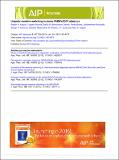Files in this item
Unipolar resistive switching in planar Pt/BiFeO3/Pt structure
Item metadata
| dc.contributor.author | Katiyar, Rajesh K. | |
| dc.contributor.author | Sharma, Yogesh | |
| dc.contributor.author | Diestra, Danilo G. Barrionuevo | |
| dc.contributor.author | Misra, Pankaj | |
| dc.contributor.author | Kooriyattil, Sudheendran | |
| dc.contributor.author | Pavunny, Shojan P. | |
| dc.contributor.author | Morell, Gerardo | |
| dc.contributor.author | Weiner, Brad R. | |
| dc.contributor.author | Scott, J. F. | |
| dc.contributor.author | Katiyar, Ram S. | |
| dc.date.accessioned | 2016-02-19T11:40:07Z | |
| dc.date.available | 2016-02-19T11:40:07Z | |
| dc.date.issued | 2015-03 | |
| dc.identifier | 223447618 | |
| dc.identifier | 71064f60-3a72-48fc-8c71-a2e850a1ec68 | |
| dc.identifier | 000352449500010 | |
| dc.identifier | 84924326384 | |
| dc.identifier.citation | Katiyar , R K , Sharma , Y , Diestra , D G B , Misra , P , Kooriyattil , S , Pavunny , S P , Morell , G , Weiner , B R , Scott , J F & Katiyar , R S 2015 , ' Unipolar resistive switching in planar Pt/BiFeO3/Pt structure ' , AIP Advances , vol. 5 , no. 3 , 037109 . https://doi.org/10.1063/1.4914475 | en |
| dc.identifier.issn | 2158-3226 | |
| dc.identifier.uri | https://hdl.handle.net/10023/8267 | |
| dc.description | This work was supported by the NASA EPSCoR Grant # NNX13AB22A. Financial support to various researchers from IFN-NSF grant # EPS 1002410 (RSK, DB, YS and BRW) is gratefully acknowledged. S. K. is thankful to UGC, India for a Raman fellowship under Indo-US 21st century knowledge initiatives (No:5-53/2013(I.C)). | en |
| dc.description.abstract | We report unipolar resistive switching suitable for nonvolatile memory applications in polycrystalline BiFeO3 thin films in planar electrode configuration with non-overlapping Set and Reset voltages, On/Off resistance ratio of similar to 10(4) and good data retention (verified for up to 3,000 s). We have also observed photovoltaic response in both high and low resistance states, where the photocurrent density was about three orders of magnitude higher in the low resistance state as compared to the high resistance state at an illumination power density of similar to 100 mW/cm(2). Resistive switching mechanisms in both resistance states of the planar device can be explained by using the conduction filament (thermo-chemical) model. (C) 2015 Author(s). | |
| dc.format.extent | 6 | |
| dc.format.extent | 1865772 | |
| dc.language.iso | eng | |
| dc.relation.ispartof | AIP Advances | en |
| dc.subject | BIFEO3 Ceramics | en |
| dc.subject | Devices | en |
| dc.subject | Polarization | en |
| dc.subject | QC Physics | en |
| dc.subject | NDAS | en |
| dc.subject | SDG 7 - Affordable and Clean Energy | en |
| dc.subject.lcc | QC | en |
| dc.title | Unipolar resistive switching in planar Pt/BiFeO3/Pt structure | en |
| dc.type | Journal article | en |
| dc.contributor.institution | University of St Andrews. School of Chemistry | en |
| dc.contributor.institution | University of St Andrews. School of Physics and Astronomy | en |
| dc.identifier.doi | 10.1063/1.4914475 | |
| dc.description.status | Peer reviewed | en |
This item appears in the following Collection(s)
Items in the St Andrews Research Repository are protected by copyright, with all rights reserved, unless otherwise indicated.

